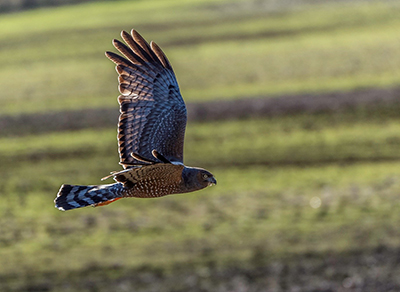There are 24 species of birds of prey in Australia, of which up to 18 can be seen in North West LLS region. Around Tamworth there are five listed threatened species (declared Vulnerable in NSW): the Square-tailed Kite, White-bellied Sea-Eagle, Spotted Harrier, Little Eagle and Black Falcon. There are even occasional, verified reports of Ospreys (a coastal species, also threatened in NSW) appearing at inland reservoirs.
The Sea-Eagle is associated with large waterbodies, but also needs a large tree in a quiet woodland patch in which to nest. They have been seen on the Peel River, at Lake Keepit and on Chaffey and Quipolly Dams, where they skilfully snatch fish from the water's surface.

Sea-Eagles will also scavenge dead animals.
The other four threatened species are birds of woodland and wooded farmland, in the case of the Spotted Harrier and Black Falcon also foraging out into grassland, crops and pasture. All four require large trees, often in quiet woodland patches but including paddock trees, for nesting and perching, and most will use dead trees as lookout posts when hunting. These four are all too small to bother lambs and rarely bother smaller livestock or domestic animals. On the contrary, they prey heavily on agricultural and urban pests.

©David Whelan / Wildpix 2016
The Little Eagle is a great rabbiter.
The Spotted Harrier takes many mice, and the Black Falcon takes many pest birds such as starlings and feral pigeons as well as some rats and rabbits. The Square-tailed Kite, a more strictly woodland bird, frequently preys on Noisy Miners – an abundant species that drives smaller bush birds away (and not to be confused with the introduced Indian or Common Myna).
An increase in mouse numbers is one likely explanation for the occurrence and breeding of Spotted Harriers recorded lately in the region. However, raptors that prey on agricultural pests are at risk of secondary poisoning from eating poisoned animals, such as a rabbits baited with pindone or rodents poisoned with the newer, single-feed rat and mouse poisons containing brodifacoum, bromadiolone or difenacoum. The older, multi-feed baits based on warfarin or coumatetralyl are safer.

©David Whelan / Wildpix 2016
Spotted Harriers sail low and slowly over crops or grass, listening with their owl-like facial ruff for rustling prey, and dropping to reach into tall growth with their long legs.
Other threats to raptors include removal of woodland habitat and paddock trees, overgrazing, and collisions with barbed-wire fences and high-speed traffic, as well as illegal persecution (shooting, trapping and deliberate poisoning) when scavenging raptors are wrongly blamed for killing the dead animal they are feeding on.
People can help our threatened raptors by:
- retaining and protecting remnant woodland and paddock trees in farmland
- adopting stocking rates that preserve ground cover
- rehabilitating watercourses with native vegetation
- reconnecting the landscape with corridors of trees
- using raptor- and owl-friendly rodent baits containing warfarin or coumatetralyl, strictly according to label instructions and disposing of dead animals
- avoiding barbed wire where practicable or marking collision blackspots in some way (e.g. with flagging tape)
- and being wildlife aware when driving and moving roadkill carcasses off roads where safe to do so.
Thanks go to Dr. Stephen Debus for writing this article for North West Local Land Services. Steve is currently working on woodland bird monitoring for regent honeyeaters in the North West but is also well known for his work on birds of prey across Australia.






